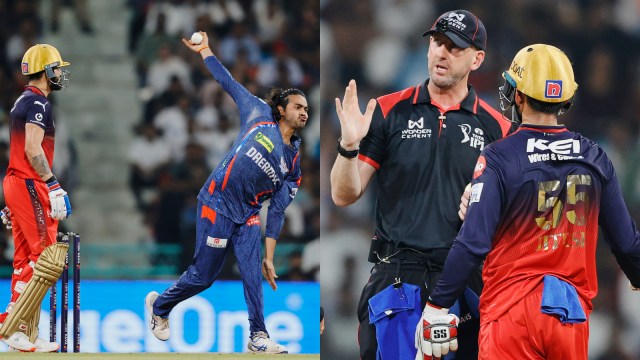ARTICLE AD BOX
 L-R: LSG's Digvesh Rathi in bowling run-out and Jitesh Sharma discussion with umpires post the run-out appeal. (Sportzpics for IPL)
L-R: LSG's Digvesh Rathi in bowling run-out and Jitesh Sharma discussion with umpires post the run-out appeal. (Sportzpics for IPL)
The high-scoring thriller during the last league game of the Indian Premier League 2025 between Lucknow Super Giants and Royal Challengers Bengaluru at the Ekana Cricket Stadium in Lucknow on Tuesday marked a controversial run-out attempt by the LSG leg-spinner Digvesh Rathi in the 17th over against Jitesh Sharma at the non-strikers’ end.
It was deemed not out after the appeal went upstairs however, there was still confusion as to whether the not-out decision was in effect because of the technical rules or was it because the LSG skipper Rishabh Pant withdrew the appeal when asked by the on-field umpires. It was also seen RCB skipper Jitesh hugging Pant after the latter withdrew the appeal and the comms calling it wrongly an ‘appeal withdrawal’ instead of clarifying the cricket rules.
Here’s a detailed explanation of why Jitesh’s run-out appeal by Rathi was deemed not out despite him being clearly out of the crease.
What does the rule say?
The MCC law of cricket rulebook No. 38.3 talks about “Non-striker leaving his/her ground early”.
The law No. 38.3.1 gives clarification on how a batter can be run out since the ball comes into play when the bowler releases the ball. The law states, “At any time from the moment the ball comes into play until the instant when the bowler would normally have been expected to release the ball, the non-striker is liable to be Run out if he/she is out of his/her ground. In these circumstances the non-striker will be out Run out if he/she is out of his/her ground when his/her wicket is broken by the bowler throwing the ball at the stumps or by the bowler’s hand holding the ball, whether or not the ball is subsequently delivered.

 LSG’s Digvesh Rathi effecting run-out against RCB captain Jitesh Sharma. (X/Screengrabs)
LSG’s Digvesh Rathi effecting run-out against RCB captain Jitesh Sharma. (X/Screengrabs)
But it is the MCC law No. 38.3.1.2 which explains why Jitesh was not out despite being clearly out of the crease even before Rishabh Pant withdrew Rathi’s appeal on behalf of LSG. The law says, “Even if the non-striker had left his/her ground before the instant at which the bowler would normally have been expected to release the ball, once the bowler has reached that point it is no longer possible for the bowler to run out the non-striker under this Law.”
Basically, the moment Rathi completed his action, he was not liable to effect a run-out in the non-strikers’ end before releasing the ball. Had it been a run-out, the fate of the match would have hung in the balance with Jitesh departing.
Story continues below this ad
RCB eventually beat LSG by six wickets to become the first team in the history of IPL to win all of their away league matches in a season. RCB won 7 out of 7 matches away from home in IPL 2025 and finished second to book their Qualifier 1 berth, where they will face table-toppers Punjab Kings in Mullanpur.



.png)
.png)
.png)

























 English (US) ·
English (US) ·